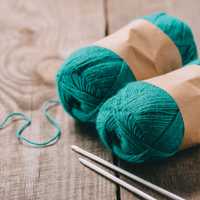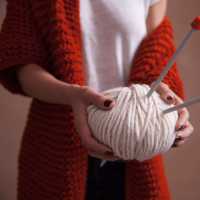Basic Knitting for Beginners
By Sarah Miller
Basic Knitting for Beginners
By Sarah Miller
So, you've decided it's time you learned how to knit. Is it some perplexing and time-consuming art to learn? No! All you need is a pair of needles and a skein of yarn. The needles can be any size that feels comfortable in your hands, or that work with your pattern. Needles can be made with a variety of materials with the most commonly available ones being made of aluminum, bamboo, and plastic. For beginners, wood or bamboo needles might be easier to work with because they catch the yarn more than metal needles do, a trick that leads to fewer dropped stitches. The yarn can be of any color, weight, or material. If you are not using a pattern, try using different materials like bamboo, wool, or acrylic to find the material you like best. If you are using a pattern, use the yarn that is specified or you may need to adjust your pattern to fit with a different yarn. When you are following a pattern it will mention gauge and tension. Gauge is the number of stitches per inch for that specific pattern, a detail which is affected by tension, or how tightly you hold your yarn as you stitch. The size of your stitches will change with different tensions, so try several different tensions until you find the one that works for your pattern.
Casting on
Now that you have your materials, the first thing you must do to start your project is cast on some stitches. A cast on is the edging for your project; it is the root of your knitting. You can cast on in many different ways, with each style producing beautiful effects, but the one of the simplest methods is the loop cast on. Start with a slip knot. Take about 6 inches of yarn and create a loop around your index finger. Place the loop on top of the tail end of your yarn. Pull the line of yarn that is in the middle of the loop up through the loop until you have another loop. Place the loop on your left needle and pull on the length of yarn that is connected to your skein, this is called the working end, until the loop is snug against the needle. The slip knot can be counted as one of your stitches or it can be used as a temporary stitch; it is your preference.
Now that you have a slip knot, you can begin with the cast on. Start with the needle with the slip knot in your left hand and the working end of the yarn in your right hand. Make a loop of yarn around your right index finger and slide your needle through the front of the loop. Pull the yarn until it is tight enough not to slip off, but not so tight that you cannot get your needles through the stitches. Once you have cast on the number of stitches you pattern indicates, it is time to use some of the basic stitches.
Knit Stitch
To make a knit stitch you will hold your needles in the palms of your hands with both points facing up, like you would hold eating utensils. Hold the working end of your yarn in your right hand behind your work. Take your right needle and hook the first stitch from the front left to the back right of the stitch. Wrap the working end of the yarn once around the point of the right needle while keeping the stitch on the left needle. Pull your needle back through the stitch without dropping the wrapped yarn. Slide the stitch off of the left needle and gently tug the working end of the yarn until the yarn is back at the correct tension for your pattern.
Purl Stitch
When you make a purl stitch, your needles are held in the same position as the knit stitch, but the working end of your yarn is held in front of your work. Hook your right needle through the stitch from the front right to the front left of the stitch. Wrap the working end of your yarn around the right needle's point and pull back through the stitch. Slide the stitch off of the left needle and gently tug the working end of the yarn.
When you reach the end of the row, switch your needles to the opposite hands. Your work should be held on the left needle and the working end of the yarn should be held with your right needle. Continue with your stitches until the pattern is complete and then bind off your work.
Binding off
To finish your work you must bind off the last row of your stitches. If you have knit stitches facing you, then you are going to use knit stitches to bind off. If you have purl stitches facing you, then you are going to use purl stitches to bind off. Make the first two stitches like you would to continue your pattern. Using your left needle, pick up the first stitch on the right needle and pull it over the second stitch to drop it off the needle. Make the next stitch and repeat the picking up and dropping off of the first stitch. Repeat this until all of the stitches have been finished and there is one stitch left on the right needle. Cut the working end of your yarn, leaving 6-8 inches of yarn to weave back into your work. Pull the end of the yarn through the stitch on your right needle and tug it gently to fasten off the stitch.
Now you know how to start your knitting project, the two basic stitches, and how to finish your project off. Knitting really is easier to understand than many people think. You just need to know the basics to get started and make some truly beautiful pieces. So go ahead and get started on your knitting adventure!
Article Source: http://EzineArticles.com/expert/Sarah_Miller/2209124
So, you've decided it's time you learned how to knit. Is it some perplexing and time-consuming art to learn? No! All you need is a pair of needles and a skein of yarn. The needles can be any size that feels comfortable in your hands, or that work with your pattern. Needles can be made with a variety of materials with the most commonly available ones being made of aluminum, bamboo, and plastic. For beginners, wood or bamboo needles might be easier to work with because they catch the yarn more than metal needles do, a trick that leads to fewer dropped stitches. The yarn can be of any color, weight, or material. If you are not using a pattern, try using different materials like bamboo, wool, or acrylic to find the material you like best. If you are using a pattern, use the yarn that is specified or you may need to adjust your pattern to fit with a different yarn. When you are following a pattern it will mention gauge and tension. Gauge is the number of stitches per inch for that specific pattern, a detail which is affected by tension, or how tightly you hold your yarn as you stitch. The size of your stitches will change with different tensions, so try several different tensions until you find the one that works for your pattern.
Casting on
Now that you have your materials, the first thing you must do to start your project is cast on some stitches. A cast on is the edging for your project; it is the root of your knitting. You can cast on in many different ways, with each style producing beautiful effects, but the one of the simplest methods is the loop cast on. Start with a slip knot. Take about 6 inches of yarn and create a loop around your index finger. Place the loop on top of the tail end of your yarn. Pull the line of yarn that is in the middle of the loop up through the loop until you have another loop. Place the loop on your left needle and pull on the length of yarn that is connected to your skein, this is called the working end, until the loop is snug against the needle. The slip knot can be counted as one of your stitches or it can be used as a temporary stitch; it is your preference.
Now that you have a slip knot, you can begin with the cast on. Start with the needle with the slip knot in your left hand and the working end of the yarn in your right hand. Make a loop of yarn around your right index finger and slide your needle through the front of the loop. Pull the yarn until it is tight enough not to slip off, but not so tight that you cannot get your needles through the stitches. Once you have cast on the number of stitches you pattern indicates, it is time to use some of the basic stitches.
Knit Stitch
To make a knit stitch you will hold your needles in the palms of your hands with both points facing up, like you would hold eating utensils. Hold the working end of your yarn in your right hand behind your work. Take your right needle and hook the first stitch from the front left to the back right of the stitch. Wrap the working end of the yarn once around the point of the right needle while keeping the stitch on the left needle. Pull your needle back through the stitch without dropping the wrapped yarn. Slide the stitch off of the left needle and gently tug the working end of the yarn until the yarn is back at the correct tension for your pattern.
Purl Stitch
When you make a purl stitch, your needles are held in the same position as the knit stitch, but the working end of your yarn is held in front of your work. Hook your right needle through the stitch from the front right to the front left of the stitch. Wrap the working end of your yarn around the right needle's point and pull back through the stitch. Slide the stitch off of the left needle and gently tug the working end of the yarn.
When you reach the end of the row, switch your needles to the opposite hands. Your work should be held on the left needle and the working end of the yarn should be held with your right needle. Continue with your stitches until the pattern is complete and then bind off your work.
Binding off
To finish your work you must bind off the last row of your stitches. If you have knit stitches facing you, then you are going to use knit stitches to bind off. If you have purl stitches facing you, then you are going to use purl stitches to bind off. Make the first two stitches like you would to continue your pattern. Using your left needle, pick up the first stitch on the right needle and pull it over the second stitch to drop it off the needle. Make the next stitch and repeat the picking up and dropping off of the first stitch. Repeat this until all of the stitches have been finished and there is one stitch left on the right needle. Cut the working end of your yarn, leaving 6-8 inches of yarn to weave back into your work. Pull the end of the yarn through the stitch on your right needle and tug it gently to fasten off the stitch.
Now you know how to start your knitting project, the two basic stitches, and how to finish your project off. Knitting really is easier to understand than many people think. You just need to know the basics to get started and make some truly beautiful pieces. So go ahead and get started on your knitting adventure!
Article Source: http://EzineArticles.com/expert/Sarah_Miller/2209124



